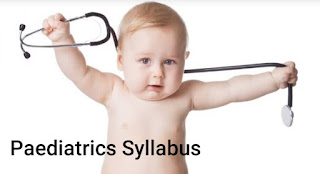FCPS PART 1 PAEDIATRICS Syllabus Under BCPS
Edition: JULY 2001
Syllbus for FCPS – Paediatrics
The objective of FCPS- Pacdiatrics will be to find out person who :
is able and willing to take responsibility for the management
of all range of acute and chronic condition in paediatrics,has the ability to adopt a problem-solving approach to clinical situation,
– is able to plan and interpret a program of investigation
appropriate to the clinical situation with due regards to
patients comfort, safety and economic capability,
has the up to date knowledge on the recent developments in
allied branches and the skill of using the available technology
for the betterment of the sick child,
is aware of the role of the pacdiatrician in health/welfare
professional team and the society and has the willingness to
work co-operatively within such team,
has acceptable communication skill for patient-doctor,
relation-doctor, nurse-doctor and doctor-doctor relation,
has the intention for maintenance and further development of
own knowledge and skill through continuing education.
Evaluation of the necessary knowledge and skill will be assessed through two stages:
Part-I : This part will assess the basic knowledge and skill
appropriate for the subject. This will include applied basic science
as detailed below in the course content together with behavior,
attitude and communication skill.
These aspect will be assessed through:
Written examination
Practical examination
Part-II : This part will assess advanced skill of data collection
footh clinical and laboratory), interpretation, judgement and
decision making. This will be evaluated through:
Written examination
Clinical examination
Sructured oral examination/OSCE
The Part 1 examination will comprise of following three written
papers :
Paper-I:
Anatomy, Behavioral Science, Medical Statistics and
Communication Skill
Paper-Il
Physiology, Clinical Biochemistry and Clinical
Pharmacology
Paper-Ill:
Pathology (Microbiology, Immunology, Virology,
Genetics, Molecular biology and Histopathology)
In the following section the course content for each paper is
claborated sometimes showing the functional aspect of it. Each of
the paper ends with a table showing distribution of question for
theory paper on cach section.
Course content
Paper 1 : Anatomy, Behavioral Science, Medical Statistics and
Communication Skill
Following are the course content for FCPS part-1 in Paediatrics in paper-1. The contents should be approached
which is relevant to Paediatrics discipline and not for surgical
or other true basic science discipline.
In the study of different parts/organs blood supply. lymphatic
drainage, structural relations are excluded (except in places
clearly mentioned in the content). However, nervous and
endocrine controls are retained.
Identification of viscera and body parts are excluded from the
examination
Cell biology : structural details of a cell with functional
implications, cell cycle, cell division and its anomalies.
Recommend meterials:
Basie Histology – Junqueira; Basic
Histology – Ross; Gray’s Anatomy
Developmental anatomy (general): Anatomical relevance of
the following physiological aspects- period of life, teratogenesis.
sensitive period of life, fetal circulation and changes at birth;
placental function, multiple pregnancy and general and
proportional growth and development of body features from birth
(as differentiated from adulthood) with onphasis
maturity.
Recommended meterials:
Embryology – Langman’s and Moore.
development of important
parts and organs, specially the ynnas, vital prians and bones,
mechanism of developmental anomalies of different organs.
Recommended book:
Embryology – Langman’s and Moure’s
General anntomy (systemic approach to the body structures):
Basic ideas on tissues Osteology, histology, development and its anomalies, important
assification centers,
Angiology including lymphoid systein-circulation through special
organs like brain, heart, kidney, liver, spleen, gut and lumes
General plan of the lymphatic drainage, and important groups of
clinically important lymph nodes and there drainage region
Recommended book:
Basic Histology . Junqueira; Gray’s
Anatomy.
Topographie anatomy (including surface anatomy) :
General body features including secondary sex characteristics:
topographic anatomy of different parts and organs of a child
including the variation in a newborn (in practical examination
relevant topics will be assessed by using bones, viscera, model and
figures).
Recommended book: Gray’s Anatomy
Histology : Light, dissecting and electron microscopic features
and their functional implications of following structures • liver,
kidney, GI tract, pancreas, respiratory passages and alveoli,
endocrine glands, heart, blood vessel, muscles, lymphoid organs
(the learning objective of this chapter will be to learn the general
histology covering the functional principle of the basic tissue. In
practical examination these parts will be assessed using projected
photomicrograph and printed photographs).
Recommended materials:
Basic listology Junqueira: Basis
Histology.
Clinical Neuronnatomy: Central and peripheral nervous
system with special importance on the development and related
anomalies, anatomy of the common injury including birth injuries.
clinical neuroanatomy in relation to joint movement.
Recommended materials:
Snell and book of NHS series.
